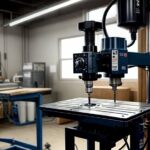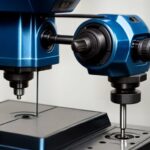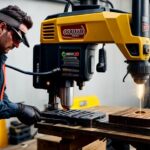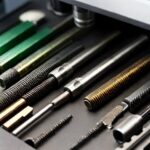Are you weary of uneven projects and crooked holes? We’ve all been there, holding a power drill with one hand and praying for the best while eyeballing a straight line. But don’t fear, fellow DIYers, since we’re here to show you that drilling precisely consecutive holes without a drill press is not only doable but also easy!
You’ll be drilling like a pro in no time with a few useful methods, the correct equipment, and a little practice. Now, set aside your expensive drill presses and join us as we delve into precision drilling, where you’ll learn to produce straight holes that will set your woodworking and metalworking projects apart from the crowd.
Prepare to raise your DIY game and wow your friends and family with your newfound drilling abilities!
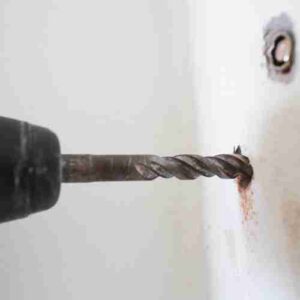 Importance of drilling straight holes in DIY projects:
Importance of drilling straight holes in DIY projects:
It is impossible to overestimate the significance of drilling straight holes in DIY projects. Whether you’re a seasoned artisan or a weekend warrior, being able to drill exactly straight holes is critical to the success and durability of your projects. These are some of the reasons why drilling straight holes are so important:
- Structural Integrity: Drilling straight holes ensures that screws, nails, or dowels are properly aligned, giving your project optimal support and stability. Misaligned holes may damage the structure over time, causing it to wobble or possibly collapse.
- Aesthetics: Straight holes help your end project’s clean, professional look. Crooked or misaligned holes may be ugly, detracting from the overall appearance and diminishing your work’s perceived worth.
- Precision and Accuracy: Accurately drilled holes are critical for preserving precise dimensions and alignment while assembling items, particularly in woodworking or metalworking applications. Straight holes ensure that everything fits together smoothly, avoiding the need for subsequent changes or repairs.
- Less Material Waste: Drilling straight holes the first time reduces the likelihood of expensive errors. Error reduction implies reduced material waste, which saves you money and resources in the long term.
- Increased Functionality: Straight holes are vital for efficient operation in projects with moving components or requiring strict tolerances, such as furniture with drawers or doors. Misaligned holes may cause components to rub together, jam, or wear out prematurely.
- Improved Safety: Straight holes that are properly drilled add to the overall safety of your DIY projects. A well-constructed and structurally sound component decreases the danger of accidents or injuries caused by instability or malfunction.
Common misconception:
Many DIY enthusiasts and novices believe that a drill press is the ultimate method for creating straight holes. This misperception is largely because drill presses are intended to give accuracy, stability, and precision that a portable power drill cannot match. On the other hand, owning a drill press is one of many options to drill straight holes, and there may be more practical answers for some.
A drill press is a useful and flexible instrument in every workshop but it has some disadvantages. For one, drill presses may be extremely costly, particularly high-quality versions. This expenditure may not be justified for infrequent DIYers or those on a tight budget.
Second, drill presses may be large and cumbersome, necessitating dedicated workshop space, which may not be accessible for people with smaller workspaces or who need to be mobile with their equipment.
The fact is that with the correct skills, gear, and experience, you can make astonishingly straight holes while using a portable power drill. Even without a drill press, you may dramatically enhance the accuracy and precision of your drilling by using drilling jigs, V-blocks, drill guide attachments, and other useful accessories.
Recognizing that a drill press is not the sole option for drilling straight holes is critical. You may obtain stunning results with your portable power drill by studying and mastering alternative ways, making your DIY projects sparkle without breaking the bank or taking up important workshop space.
Choosing the Right Tools and Materials:
A. Choosing the Right Drill Bit
- Wood vs. metal drill bits: Different materials need different drill bits, and choosing the correct one is critical for clean and precise drilling. Metal bits have varied tip angles and smaller flutes for effective drilling in metals, while wood bits have a pointed tip and large flutes for removing wood chips.
- Forstner bits, standard twist drills, and brad point drills: Conventional twist drills are useful for various materials, including wood, metal, and plastic. Forstner bits are great for drilling big, clean, flat-bottomed holes in wood, such as installing cabinet hinges or making hardware recesses. Brad-point drills feature a sharp center point that aids in precision drilling in wood and reduces the possibility of the bit straying.
B. Recognizing the significance of a sharp drill bit
Drilling straight holes requires a sharp drill bit. Dull bits may cause the drill to wander, making it harder to stay on track. Moreover, a dull bit requires greater power, which may lead to user weariness and blunders. Sharpening or replacing worn-out drill bits regularly will guarantee clean and precise drilling.
C. Purchasing a high-quality power drill
A dependable and strong drill is required for drilling straight holes. A drill with variable speed control, a level indicator, and a comfortable grip is ideal. A high-quality drill will improve performance, precision, and longevity, making it an excellent purchase for any DIY enthusiast.
D. The Function of Extraneous Accessories
Clamps and vice grips: Clamps or vise grips to secure your workpiece can prevent it from moving or rotating while drilling. Maintaining precision and drilling straight holes requires a steady workpiece.
Before drilling, use a carpenter’s square or speed square to mark and confirm the alignment of your drill bit. You may guarantee drilling at an exact 90-degree angle by aligning your bit with the square.
A center punch and hammer are used to make a tiny indentation in the material before drilling, which guides the drill bit and keeps it from straying. Place a center punch on the spot where you want to drill and pound it lightly with a hammer to produce a dimple.
 Techniques for Drilling Straight Holes:
Techniques for Drilling Straight Holes:
With the appropriate skills, you can master the art of drilling straight holes without a drill press. These are several common and efficient strategies for improving drilling accuracy with a portable power drill:
A. Making use of a drilling jig
- The advantages of utilizing a drilling jig: A drilling jig is a device that guides your drill bit during drilling, ensuring it stays straight and aligned. Jigs give support and stability, lowering the possibility of bit wander and resulting in cleaner, more precise holes.
- There are many kinds of jigs on the market: Commercial drilling jigs for specialized uses, including doweling jigs, pocket hole jigs, and angle drilling jigs, are available. These jigs are intended to ensure accuracy and convenience for certain drilling jobs.
- Make a simple and efficient homemade drilling jig by cutting a small piece of wood at a 90-degree angle. Drill a straight hole through the middle of the block using the appropriate bit size. The jig should then be clamped to your workpiece and used as a guide for your drill bit.
B. Making use of a V-block
What is a V-block and what does it do? A V-block is a tool intended to hold cylindrical or irregularly shaped items when drilling firmly. The V-shaped channel cradles the workpiece, keeping it from rolling or moving throughout the drilling operation and ensuring precise and straight holes.
Commercial vs. handmade V-blocks: You may buy professionally built V-blocks or make your own from scrap wood or metal. A basic DIY V-block may be made by carving a V-shaped groove into a block of wood or metal and attaching it to your work table to keep your project steady.
C. Making use of the drill guide attachment
Drill guide attachments come in various styles and are meant to mount onto your power drill and function as a portable drill press. They are available in a variety of forms and designs, with some including built-in levels, depth stops, and angle adjustments for more accuracy and adaptability.
Use of a drill guide attachment:
- Before using a drill guide attachment, secure your workpiece using clamps or a vise.
- Connect the guide to your power drill and make any necessary adjustments to the angle and depth settings.
- Align the guide with the mark on your workpiece and begin drilling with uniform pressure and speed. The drill guide will assist you in keeping your bit straight and aligned as you work.
Expert Tips for Drilling Straight Holes:
Following these expert recommendations for drilling straight holes, you may attain professional-quality results without a drill press. These pointers will assist you in refining your technique and increasing the overall accuracy of your drilling:
A. Begin with a pilot hole
Before drilling the full-sized hole, drill a tiny pilot hole. Pick a bit smaller than the final hole size for your pilot hole and drill it straight. A pilot hole aids in guiding the bigger drill bit, limiting the possibility of bit wander and assuring a straight route.
B. Using a mirror or laser level to check drill alignment
Put a mirror or a laser level next to your drill bit to ensure proper alignment. Any changes in the angle will be highlighted by the reflection or laser line, enabling you to alter and maintain a straight drilling path.
C. For consistent hole depths, use tape or a depth stop.
When drilling numerous holes with the same depth, mark the appropriate depth on your drill bit using masking or painter’s tape. You may also use a drill stop collar, an adjustable ring clamps onto the bit to regulate depth. This method assures uniform hole depths and a cleaner, more professional finished product.
D. Exercising correct drilling technique and speed control
During drilling, keep a constant and uniform pressure on the bit and avoid pressing too hard or too rapidly since this may create bit wander and crooked holes. Start slowly and progressively raise the speed of your power drill with the variable speed control. This method provides more control and cleaner, straighter holes.
E. Maintaining a clean and well-lit work environment
Precision drilling requires a clean, clutter-free, and well-lit workplace. A clean workstation reduces distractions and possible risks, while good illumination lets you see your marks and alignment properly. Set up an ordered and well-lit space before drilling to achieve the best potential outcomes.
 Troubleshooting Common Problems:
Troubleshooting Common Problems:
Drilling straight holes may be difficult, even for seasoned DIYers. Knowing about typical challenges and how to deal with them may make a major difference in the quality of your work. These are some common issues and solutions to assist you in troubleshooting:
A. Dealing with drill bit wander
When a drill bit wanders, it drifts away from the planned drilling path. To avoid this, start with a smaller pilot hole, produce an indentation with a center punch, or use a drilling jig to guide the bit. Maintain consistent pressure and speed while drilling to keep the bit on the course.
B. Handling angled or crooked holes
Check the alignment of your drill bit before drilling if your holes are coming out at an angle or crooked. To check that your bit is at a 90-degree angle to the workpiece, use a carpenter’s square, a speed square, or a mirror. A drill guide attachment may also aid in maintaining accurate alignment throughout the drilling operation.
C. Adjusting inconsistencies in hole depths
To achieve consistent depth, drill each hole with steady and equal pressure. Mark the appropriate depth on your drill bit with masking or painter’s tape for consistent hole depths. Instead, a drill stop collar may be used to regulate the depth precisely.
D. Reduce tear-out and chipping
As the drill bit departs the material, it may cause tear-out and chipping, producing an unattractive and rough edge. To avoid this problem, use a sharp drill bit and drill at a moderate, steady pace when the bit departs the material. To offer extra stability and avoid tear-out, insert a sacrificial piece of wood or material beneath the workpiece.
What can I use instead of a drill press?
You may get comparable results using other equipment and approaches if you still need a drill press. Although these options may give a different degree of accuracy and stability than a drill press, they may be effective for less essential applications. Among the choices are:
- Handheld power drill: A multipurpose instrument for drilling holes in various materials. Maintain a firm hand when drilling and attempt to maintain the drill perpendicular to the workpiece. Using a drill guide and clamping the workpiece may assist in increasing accuracy.
- Drill guide: Connect this to your portable power drill to help you drill at a regular angle. This method may give better stability and control than freehand drilling.
- Doweling jig: This instrument is intended exclusively for drilling precise, perpendicular holes in wood. It may be used to increase accuracy with a portable power drill.
- Hammer and nail or center punch: For tiny pilot holes, tap a nail or center punch with a hammer to produce an indentation, then drill the hole with a portable power drill.
- Awl: An awl forms a tiny indentation in the workpiece, a starting point for the portable power drill.
- Brace and bit: A brace and bit is a manual drilling instrument comprising a U-shaped brace and a drill bit. This instrument may bore holes in wood with great accuracy and control.
Frequently Asked Questions (FAQs):
1. Can I drill straight holes with a handheld power drill?
Yes, you can drill straight holes with a handheld power drill by using the right techniques, tools, and materials. Using a drill jig, V-block, or drill guide attachment can significantly improve the accuracy and precision of your drilling.
2. What is the difference between wood and metal drill bits?
Wood drill bits have a pointed tip and large flutes for removing wood chips, while metal drill bits have varied tip angles and smaller flutes for effective drilling in metals. It is essential to choose the correct drill bit for the material you are working with to ensure clean and precise drilling.
3. How can I prevent my drill bit from wandering?
To prevent drill bit wander, start with a smaller pilot hole, create an indentation with a center punch, or use a drilling jig to guide the bit. Maintain consistent pressure and speed while drilling to keep the bit on course.
4. How can I ensure consistent hole depths when drilling?
To achieve consistent hole depths, drill each hole with steady and equal pressure. Mark the appropriate depth on your drill bit with masking or painter’s tape or use a drill stop collar to regulate the depth precisely.
5. Can I use a doweling jig or an awl to drill straight holes?
Yes, you can use a doweling jig or an awl to help you drill straight holes. A doweling jig is designed specifically for drilling precise, perpendicular holes in wood, while an awl forms a small indentation in the workpiece, providing a starting point for the portable power drill.
6. How can I reduce tear-out and chipping when drilling?
To reduce tear-out and chipping, use a sharp drill bit and drill at a moderate, steady pace when the bit exits the material. Place a sacrificial piece of wood or material beneath the workpiece to provide additional stability and prevent tear-out.
Last words:
Drilling straight holes without a drill press is not only conceivable, but it can also be done with astonishing precision if the proper methods, equipment, and materials are used. You may improve your drilling abilities and obtain professional-quality results in your DIY projects by using drill jigs and V-blocks, choosing the suitable drill bit and keeping a sharp edge.
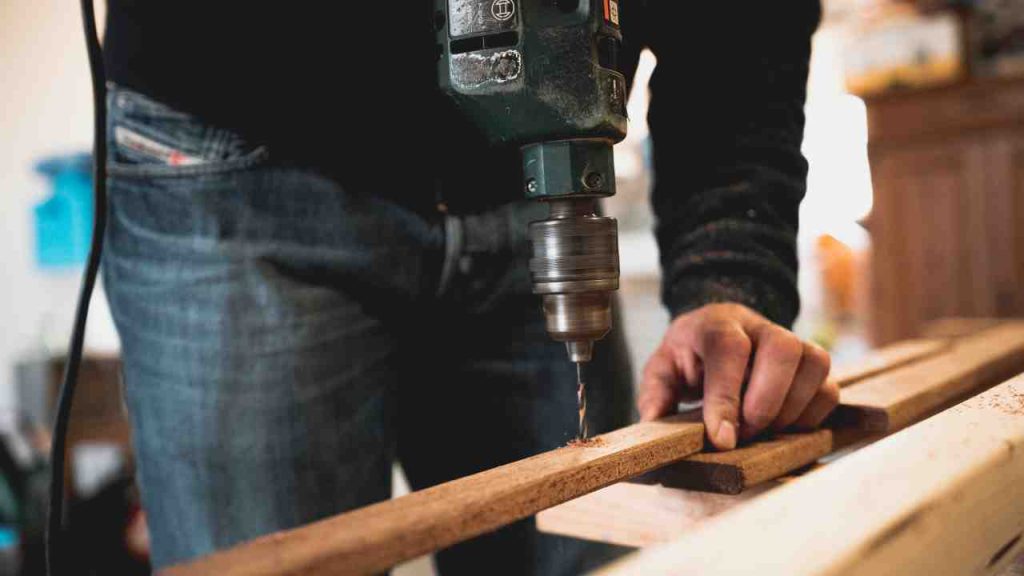
Remember that practice makes perfect, and your skill to drill straight holes will only improve with time and expertise. You may confidently improve your craftsmanship and tackle even the most challenging jobs by investing in high-quality equipment, learning alternative approaches, and addressing frequent errors. Now be ready to drill and take your DIY game to the next level!
- Where are WEN drill presses made? - April 2, 2023
- Where are Rikon drill presses made? - April 1, 2023
- Where are Powermatic drill presses made? - April 1, 2023


